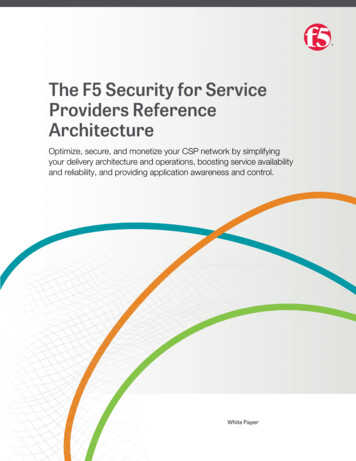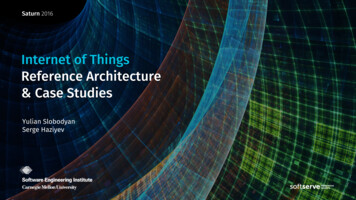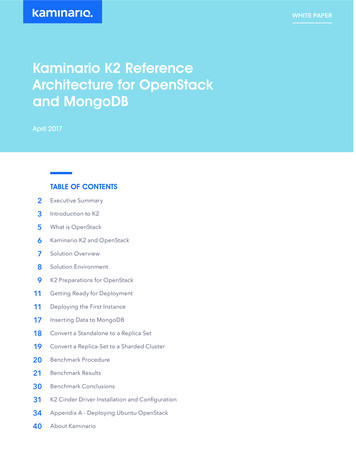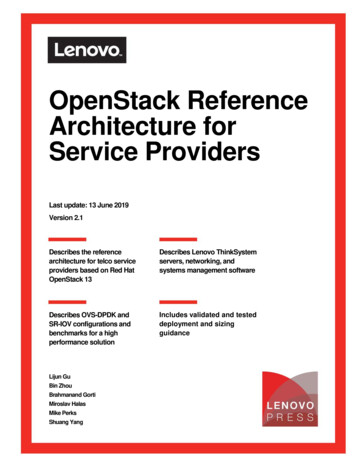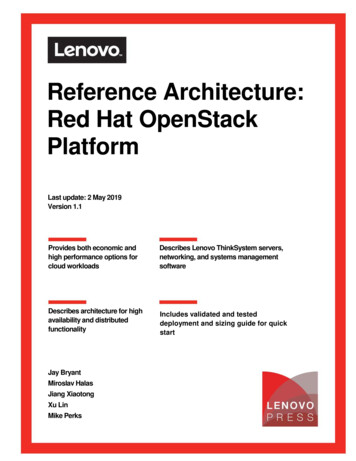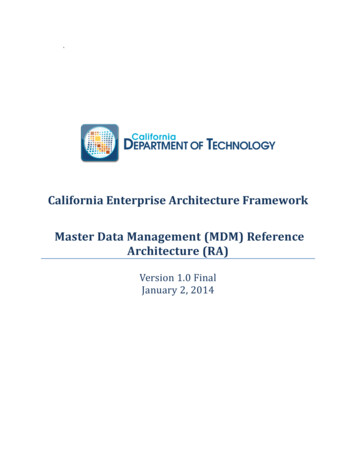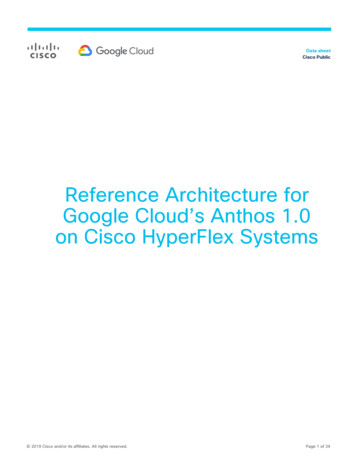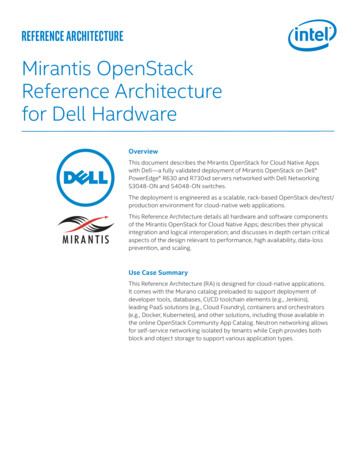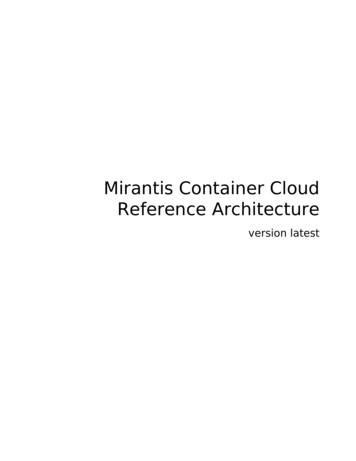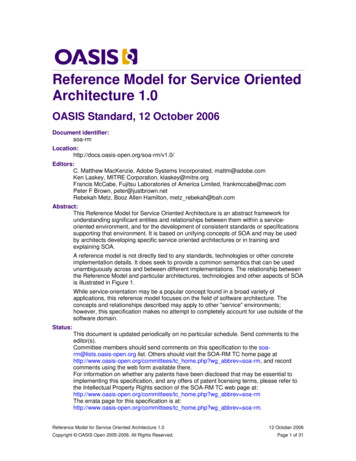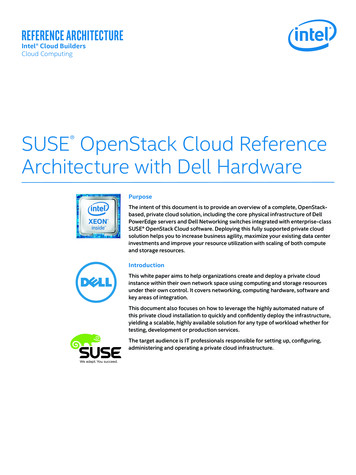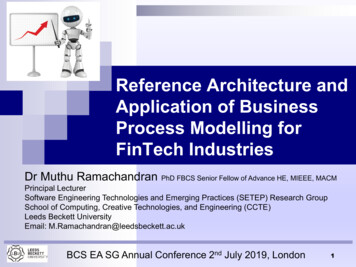
Transcription
Reference Architecture andApplication of BusinessProcess Modelling forFinTech IndustriesDr Muthu Ramachandran PhD FBCS Senior Fellow of Advance HE, MIEEE, MACMPrincipal LecturerSoftware Engineering Technologies and Emerging Practices (SETEP) Research GroupSchool of Computing, Creative Technologies, and Engineering (CCTE)Leeds Beckett UniversityEmail: M.Ramachandran@leedsbeckett.ac.ukBCS EA SG Annual Conference 2nd July 2019, London1
In this talk Main Motivation for Research into FinTech IndustryWhy Service Driven?Evolving a SOA driven reference architecture for financial cloudservices?SEF-SCC & BPD-SCC Design Principles Cognitive Architectures (predicting the future of software architecture) FinTech Cloud Applications: Domain and Feature ModellingPredictive Modelling & Technologies for Financial Cloud: AI, ML,Smart Devices, IoTs, Cloud, Blockchain TechnologiesConclusion and Questions2
Leeds Beckett University Leeds Beckett is the fifth best uni in thecountry for producing CEOsBeckett breeds more business leadersthan Oxford, LSE or Leeds UniThe data, released byEmolument, studied 26,000 graduatesacross the UK – and found that Beckettproduces 3.1 per cent of the UK’s CEOs,CTOs and Partners.3
Research Groups at Leeds BeckettSoftwareEngineering: CBSE& PLE, ServiceComputing, KESE,Agile SE, SystemDynamicsIT and Sustainability Assistive technologies andcomputer forensics andsecurity AI, Machine Learning,Robotics Data Science, SoftwareEngineering, SOA, IoT, andCloud Computing QualityEngineering: SPI,QoS, Testing, SWQuality, GreenComputing,EmergencyResponse SystemsSoftware SecurityEngineering: CloudComputing, CloudSecurity, Big Data,Distributed Database,Mobile & DistributedComputingHolistic approachto computerscience research4
Current & Some Previous Projects Software Engineering – Reuse Framework, ComponentModel for Complex Systems, used in various Industriesincluding Philips, Image Systems, Volantis SystemsResearch, etc., SPI, Testing, Software Product LineEngineering Software Engineering Framework for Service and CloudComputing Cloud Computing and Big Data – Cloud ComputingAdaption Framework (CCAF, IEEE SC 2016), DynamicService Component Model, Big Data and ResiliencyFramework (FGCS 2015) Software Security Engineering Research: VulnerabilityTechniques, Security Improvement, Design for SoftwareSecurityExample of a complexcode analytics5
Main Theme Digital economy, digital currencies, and advancement in information technology havecontributed to tremendous growth in the global economy and financialisation.The positive impact of technology on the financial services sector in the United Kingdom isunprecedented globally (The Rt Hon Liam Fox MP, Secretary of State for International Tradeand President of the Board of Trade) UK FinTech State of the NationIn order to have contributed sustain this growth, a systematic approach is necessary for allaspects of the financial process and applications. Holistic Approach to FinTech in the cloud Software Engineering Framework for Service and Cloud Computing (SEF-SCC):Application to FinTech Cloud Business Process Driven Approach to Service and Cloud Computing (BPD4SCC): OurModel Requirements Engineering Framework for Cloud Computing Design Approaches to FinTech Applications (Service components with SoaML,Containers, Smart Contract with Blockchain, etc) Machine Learning Approaches to FinTech Refining, Improving & Reusing Service Requirements for Financial Services Bug Prediction Models with Data Science Approach6
MOTIVATION FOR THIS TALK:FINTECH7
Fintech: Ant Financial Services, China8
Digital revolution vs. Challenges for Financial ServiceSectors: FinTech Claims FINANCIAL TECHNOLOGY, ALSO known as fintech, is a fast-evolvingfield that has reshaped the financial industry.Financial service providers face major challenges when digitizing servicefor the future economy: Customers and Businesses vs. Low-cost vs. Fastvs. Risks vs. Trust vs. Intelligent Way of providing business servicesAnt Financial focuses on five technologies: Blockchain, AI, Security, IoT,and Computing (BASIC) or also known as AI, Blockchain, Cloud, DataAnalytics (ABCD)Ant Financial has redefined digital financial services, specifically mobilepayment and microloan services, and Ping An Technology has developed.The innovation of QR payment builds a point-of-sale transaction (offlinepayment) for remote villages in the foot steps of mount Everest. Decisionsmade instantly for microloans and car accidental damages with customersent photosFintech: AI Powers Financial Services to Improve People’s Lives BY YUAN QI/ANT FINANCIAL, JING XIAO/PING AN TECHNOLOGY (SHENZHEN)CO., LTD. NOVEMBER 2018 VOL. 61 NO. 11 COMMUNICATIONS OF THE ACM, m7te 9
UK FinTech 1UK FinTech (2019) State of the vernment/uploads/system/uploads/attachment 10
UK FinTech 2 UK start-up into a global market leader in FinTech worth over 35bn.The question now, is how can the UK keep up with the demand forthe skills that will support the future success of FinTechs?Research from the World Economic Forum shows that emergingroles – such as, data analysts, AI and machine learning specialists,designers, and people who work in innovation roles – whichcurrently account for 15% of the financial services workforceglobally, are expected to account for 29% of the workforce by2022.Future of Technology Trends: Blockchain (identify management,Voting, etc), Drones (insurance claim validation in disastersituations), IoT (mobile banking, inventory and materials tracking,real-time asset monitoring (gold reserve, etc.), Robots (hotel andtourism service industry), 3D Printing, VR, AR, and AI.11
Main Finding of Fintech Their main findings Blockchain provides a new trust mechanismto transactions Deep learning and natural languageprocessing technologies helped intelligentcustomer service robots achieve highercustomer satisfaction rates than live servicestaffs AI Assessment of Claims and Risks forInsurance and Loans Sectors12
WHY SERVICE DRIVEN?13
Why SOA? Service Computing of Everything: Internet ofEverything (IoE) for the Future of Business ITThe Future is here!Why SOA? Multitude of devices, seamless data, intelligence,multitude of software, systems, services, and platformintegration, and predictions. The Future is here!SOA is a formalised way of integrating applications existingtraditional applications and legacy systems) into an enterprisearchitecture and hence suitability for connecting IoEs14
YESTERDAY: GADGETS ARE EVERYTHINGToo bad theyCoolcan’t talk totoys each other
TODAY: COMMUNICATION IS EVERYTHINGConfiguration?Too much work Sync.Download. Done.
Tomorrow: Service is Everything: they communicate,compose new services, and self recover themselvesThank God!Everything isdone for me!
Connecting Services is Here with 5G18
Cybersecurity Risks with 5G19 5G and 6G is great for connecting services with Cloud, Big DataAnalytics with AI/ML/DL, Robotics, Blockchain, IoT TechnologiesHowever, if the application services are not engineered (design forsecurity/Build-In Security (BSI)), we will have sever consequencessimilar to what we have seen in moviesIt could destroy power grid, transportation, financial services, simplyevery seconds of day-to-day life (Dr Ian Levy, Technical Director ofthe National Cyber Security Centre, BBC Click Interview, May 2019(the future of cyberwarfare)5G Click InterviewTherefore, it is paramount to use Cybersecurity ImprovementFramework
Why BPM (Business Process Management BPMN CMMN DMN) for Financial Services and Financial CloudBased Applications?EVOLVING A REFERENCEARCHITECTURE FOR FINTECH20
Service-Driven IT is the Future: SOA ParadigmService ProviderService RequesterSOAP/RESTful to communicateand exchange messageWeb ServiceDirectories (UDDI,Google, AmazonAWS, Azure, etc)WSDL to describe servicesThe main focus and purpose is customer driven methods, processes(applicable to both traditional as well as Agile based), and technologies21
Basic Principle of 3-tier Architecture ModelThe top layer is called role-based Web access layer, which provides convenient, safe, barrier-freeinformation access portal for all participants in the collaboration. Its specific functions includeinformation browse, search, subscriptions. The middle layer is called application logic layer that reflectsthe interact logic among person, activities and information. Its specific functions include collaborativeprocess management, information sharing and reuse, integration with existing systems. The bottom layeris data storage layer, whose main role is to change product data into knowledge wealth. Its specificfunctions include information capture, storage, sorting, enriching, structuring and summary.Jiang, J., Zhao, F., and Qiu,, N (2012) SOA-based Architecture of Collaborative Product Commerce, 2012 IEEESymposium on Robotics and Applications(ISRA)
What is BPMN?Duma, M, La Rosa M, Mendling, J and Reijers, H.A (2018) BPM, 2nd Edition23
BusinessProcess DrivenApproach toService andCloudComputing(BPD4SCC):Our ModelService Requirements with BPMN Initial process models: Actors/roles/Workflows Detailed workflows Service Task modelling UI prototyping Process Simulation: Configure Resources need for tasks Load profiles in sec/min/days/no.of instances Start the Process Simulation as a Service (PSSaaS)SOA Requirements with use case modelling, story cards, (Agile), Story Boards, CRC Cards, Feature-OrientedmodellingSOA Design with Service Component Models (Design Techniques using UML component model &SoaML)SOA Implementation with SOAP/RESTfulSOA Test & Deliver24
Software Engineering Framework forService and Cloud Computing (SEF-SCC):Application to FinTech CloudMethod, Process, Framework, Architecture, Design PrinciplesMethods and Design PrinciplesProcess: Business Process Driven Service Development Lifecycle (BPD-SDL)Reference ArchitectureToolsSE-SCC Services: Software Engineering as a Service (SEaaS): SPMaaS, SPIaaS,SSREMaaES, CCAFaaS, SE for BD, SE for IoT, SE for Cyber-Physical SystemsAdoption ModelsEvaluation & Applications
DesignPrinciples Reuse of Financial Services with ML High Level Abstractions: Lightweight vs.Heavyweight abstractions: ServiceComponents, Microservices, and Containers Privacy and Security: BPMN and SoaMLDriven Validation before Implementationwith Business Process Driven ServiceDevelopment Lifecycle Smart Contract with Blockchain Technology Comparative Design Strategies The Sherwood Applied Business SecurityArchitecture (SABSA) is a framework fordeveloping risk-driven enterpriseinformation security and assurancearchitectures. It defines attributes suchas reputation, operational efficiency,business continuity and brandperception. These attributes, and others,need to be protected through securitycontrols. https://www.youtube.com/watch?v qbFTg85I4eE
Design Abstractions27ObjectsComponentsDesign mponentsPackagingVirtual ResourceorientedabstractionSmart Contractsbased onBlockchainConceptIncreasingLevel ofabstractions
Concept of a generic SOA Based ReferenceArchitecture: Aspect of Layering AbstractionJiang, J., Zhao, F., and Qiu,, N (2012) SOA-based Architecture of Collaborative Product Commerce, 2012 IEEESymposium on Robotics and Applications(ISRA)
Design Principle on web services granularity: An Example ofoutsourcing parts shipping / delivering processIf the granularity is too small, the service may be too specific to beuseful. If the granularity is too large, it leads to a general applicationspecific service which cannot be reused. Then, the service should bebroken into smaller parts. XIAO Jie; CAI Fang; WU Dan; DU Jie. Study of SOA-based CRM SystemArchitecture, Microcomputer Information [J], 2009.12, PP:46-48
FAaaS (Financial Applications as a Service) Component Model
Financial Accuracy & Predictive MathematicalModels & Algorithms Models behind FAaaS are essential for the calculation, processing andpresentation of financial computation in the Cloud. 1. Heston Model 2. Wiener Process 3. CIR (Cox, Ingersoll and Ross) Model 4. Runge–Kutta method (RKM) The use of all the models for FSaaS can match accuracy and optimizethe performance.
SEF-CC Reference Architecture for Service Computing32Focus on new servicecomposition for newbusiness creation &choreographyOrchestration & Co-ordinationServicesBusiness ServicesFocus on user-centricbusiness services suchas secure access, etcBusiness Utility and Coordination Services(task-oriented, entityoriented & enterpriseoriented services)EnterpriseService BusInfrastructure Core y ServicesInfrastructure coordination services
Mapping Services to SOA Design33Task orientedservicesEntity orientedservicesEnterpriseservices CoordinationCoordinationCoordinationAs an Architect, you will need to categorise services therefore you will be able toplace them in the appropriate architecture layers on the right
Reference Architecture for Financial Cloud34Business LayerOrchestration LayerRegistration,Authentication &Security ControlConsumerBankingApplicationsMulti-channel servicerequestsMobile, Cloud, IoTSensors, SocialMedia, Email, QRcode, vouchers,Drones, etcSecure Enterprise Service BusConsumerBankingInvestmentBankingSavings &Deposit ServicesCurrent AccountServicesLoan ServicesFinancial Analytics LayerB2B, B2C,B2GovCryptocurrenciesPredictiveModelling forFinancialServices withMachine Learning& Deep LearningBusiness Services (B2B,B2C, B2Gov, etc.Governance Services (FCA Regulations) with SmartContract)Infrastructure LayerBusiness Regul
shows that emerging roles – such as, data analysts, AI and machine learning specialists, designers, and people who work in innovation roles – which currently account for 15% of the financial services workforce globally, are expected to account for. 29% of the workforce by 2022.

